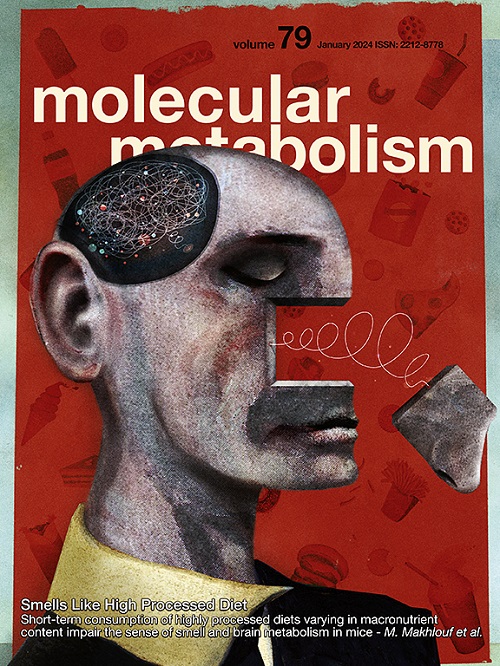Excessive exercise elicits poly (ADP-ribose) Polymerase-1 activation and global protein PARylation driving muscle dysfunction and performance impairment
IF 7
2区 医学
Q1 ENDOCRINOLOGY & METABOLISM
引用次数: 0
Abstract
Excessive exercise combined with inadequate recovery time may trigger fatigue, performance impairment, and ultimately the overtraining syndrome. The intramyocellular mechanisms involved in the overtraining syndrome remain only partially known. Here, we combined multi-omics analyses from isogenic BXD mouse strains with a mouse model of overtraining and excessive exercise protocol in mice and humans to evaluate the molecular mechanism involved in the performance impairment induced by excessive exercise. We identified that BXD mouse strains with elevated levels of Parp1 gene expression in the skeletal muscle displayed features like overtraining syndrome and abnormal muscle genetic signature. High PARP1 protein content and aberrant PARylation of proteins were detected in the skeletal muscle of overtrained, but not in trained mice. Overtraining syndrome reduced mitochondrial function promoted by exercise training, induced muscle hyperalgesia, reduced muscle fiber size and promoted a similar gene signature of myopathy and atrophy models. Short periods of excessive exercise also increased PARylation in the skeletal muscle of mice and healthy subjects. The pharmacological inhibition of PARP1, using Olaparib, and genetic Parp1 ablation, preserved muscle fiber morphology and protected against physical performance impairment and other symptoms of the overtraining syndrome in mice. In conclusion, PARP1 excessive activation is related to muscle abnormalities led by long or short periods of excessive exercise, and here we suggest that PARP1 is a potential target in the treatment and prevention of overtraining syndrome.
过度运动引起多聚(ADP-核糖)聚合酶-1活化和全局蛋白 PARylation,导致肌肉功能障碍和运动表现受损。
过度的运动加上不充分的恢复时间可能会引发疲劳、表现障碍,最终导致过度训练综合征。过度训练综合征的细胞内机制仍然只是部分已知。在此,我们将等基因BXD小鼠品系的多组学分析与小鼠和人类过度训练和过度运动方案的小鼠模型相结合,以评估过度运动引起的表现障碍的分子机制。我们发现骨骼肌中Parp1基因表达水平升高的BXD小鼠品系表现出过度训练综合征和异常肌肉遗传特征。在过度训练的小鼠骨骼肌中检测到高PARP1蛋白含量和异常的PARylation蛋白,而在训练小鼠中则没有。过度训练综合征降低了运动训练促进的线粒体功能,诱导肌肉痛觉过敏,减少了肌纤维大小,并促进了肌病和萎缩模型的相似基因特征。短时间的过度运动也增加了小鼠和健康受试者骨骼肌中的PARylation。使用奥拉帕尼对PARP1进行药理学抑制和基因PARP1消融,可以保护小鼠的肌肉解剖结构,防止身体机能障碍和其他过度训练综合征的症状。综上所述,PARP1过度激活与长时间或短时间过度运动导致的肌肉异常有关,我们认为PARP1是治疗和预防过度训练综合征的潜在靶点。
本文章由计算机程序翻译,如有差异,请以英文原文为准。
求助全文
约1分钟内获得全文
求助全文
来源期刊

Molecular Metabolism
ENDOCRINOLOGY & METABOLISM-
CiteScore
14.50
自引率
2.50%
发文量
219
审稿时长
43 days
期刊介绍:
Molecular Metabolism is a leading journal dedicated to sharing groundbreaking discoveries in the field of energy homeostasis and the underlying factors of metabolic disorders. These disorders include obesity, diabetes, cardiovascular disease, and cancer. Our journal focuses on publishing research driven by hypotheses and conducted to the highest standards, aiming to provide a mechanistic understanding of energy homeostasis-related behavior, physiology, and dysfunction.
We promote interdisciplinary science, covering a broad range of approaches from molecules to humans throughout the lifespan. Our goal is to contribute to transformative research in metabolism, which has the potential to revolutionize the field. By enabling progress in the prognosis, prevention, and ultimately the cure of metabolic disorders and their long-term complications, our journal seeks to better the future of health and well-being.
 求助内容:
求助内容: 应助结果提醒方式:
应助结果提醒方式:


